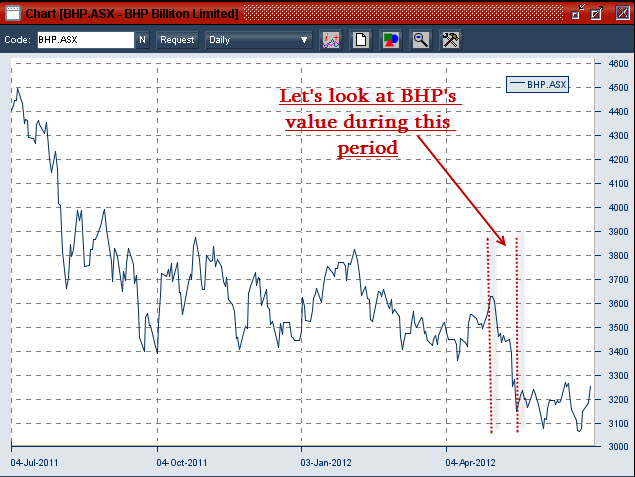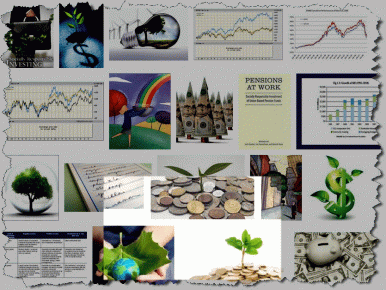Financial media have started using the terms “risk on” and “risk off” to describe the daily swings that are so vividly apparent in market pricings around the world. Just what do these terms refer to?
Markets are priced at the margin
Deep breath, and please bare with me on this one because it is extremely important to your understanding of money and markets in todays’ credit constrained world.
Markets are priced at the margin.
In other words, the fact that you hold BHP shares does nothing to determine the daily pricing of BHP shares. It is only the transactions of people who have agreed to buy or sell their BHP shares on a given day that determine the price of BHP on a given day.
That may sound obvious but it isn’t really. In fact, it is counter-intuitive to the way that most people look at the valuations of a company, in the same way that most people keep a figure in their head for the value of their home – even though other similar homes nearby may sell for a completely different price.

What if you had to stick a “For Sale” sign in front of your house every single day – and take whatever price you were offered each and every day? (image source: http://www.guardian.co.uk/money/2009/jun/09/rics-house-prices the article is interesting because it is 3 years old and has not turned out to be very accurate.)
If you were to see the “market price” of your home every single day, you’d probably need sedatives. That’s because the market price is the price that you would get if you hung out a “must sell today” sign on your door, and you basically were forced to take whatever the highest offer was – even if it were significantly lower than your estimation of the price it should sell at. It is highly likely that your home “market price” would fluctuate at a greater rate than the sharemarket – simply because there aren’t a lot of people wandering the streets with half a million dollars (plus+) of loose change at any given point in time. On some days, you would receive a ridiculously low price while on others you may end up with competing bidders lifting the price above your expectations.
And so we return to the sharemarket, and a look at BHP’s price. BHP is the world’s largest mining company, so a great deal of its shares are held by overseas investors, who view Australia as a fringe dweller in the world of finance. We may have the 4th largest AAA rated sovereign bond market in the world, a Top 10 ranked pool of retirement savings, and one of the most sophisticated retail financial markets no the planet – but to most overseas investors, we are a rock quarry with the occasional gold, coal or oil seam running through it.
Please remember the Great Disclaimer – Nothing in this post or on this website is to be considered personal advice. You must not take any investment action based on the content of this site, as statements here take no account of your personal financial situation. That is – what seems logical enough when written here, may be completely illogical and incorrect when applied to your personal financial position. Also note that past performance provides no guarantee to future performance. All discussion on this site is broad discussion on possibilities, trends, and background on some of the ways that money does or does not, make sense.
I am going to look at BHP and Newcrest as examples for considering this or that impact on share prices. This is not a recommendation to buy, sell or hold either of these companies, nor is it a reflection of anything other than my choice of them as being the biggest (BHP) and one of the more volatile (Newcrest ‘NCM’). As operators in basic commodities and gold, these two companies bare the brunt of a lot of speculation in the current economic environment.
Let’s pick on BHP
BHP is dual listed on both the London Stock Exchange and the Australian Stock Exchange. For simplicity, i’ll refer to it as BHP, even though it is BHP Billiton, and it is dual listed. Here’s a look at BHP’s Australian shareprice movements over the past year.

BHP shares would appear to be out of favour. Is the company really worth billions of dollar less than it was a year ago?
You can see that the recent departure of many commodity speculators has left a rather large dent in the demand for the shares. Looking at the share price, you would reasonably deduce that something has gone wrong with the company – that it is in trouble or that some highly dramatic event is impacting on it. Let’s consider some of these points for just a little while…
Here’s a look at the performance of BHP against the overall market index, as measured by the S&P/ASX 200 Price Index. Remember that BHP makes up around 8-10% of that price index, so its share price changes are going to impact the index itself quite heavily.

A comparison of BHP’s daily shareprice against that of the overall market – as measured by the Exchange Traded Fund (“ETF”) with a code of STW, which is based on the S&P/ASX200 Price Index.
It would seem that BHP shared the market’s pain and glory for the first half of the year but things turned decidedly against BHP’s favour early in the new 2012 year, at which stage BHP’s shareprice fell at a greater rate than the overall market.
Now let’s get back to the topic at hand. How is BHP’s shareprice reflecting the market estimation of BHP’s total (Australian listed) value? This can be a huge topic but we’ll try to keep it relatively brief – so i’m going to focus on one small but very volatile time period.

Let’s narrow our look at BHP’s share price movements down to a period where there was a very clear movement down in the daily price levels.
You can see that BHP’s price fell considerably during this brief ~2 week window of time. What actually happened here? Let’s start by having a quick look at the publicly available material of the kind that most people would consider when making a decision to buy or sell BHP (assuming that most people have a choice… many people would have to sell regardless – for other purchases, for other investments, as part of estates or fund mandate changes, etc, etc, etc). We are going to ignore the economic environment. That is, we are ignoring China’s predicted (and government mandated) ‘slowdown’
Here’s a quick overview of BHP’s share based information. It is as at the 18th May (which is when i first started collecting thoughts for this post).
| Shares | 3,211,691,105 |
| Market Cap | 105,247,117,511 |
| Prev. Close | 32.77 |
| NTA | 11.69 |
| Value | 37,544,669,017 |
| Div on value | 8.82% |
| Earnings | 3.9733 |
| Amount | 12,761,012,267.50 |
| Dividend | 1.0308 |
| amount | 3,310,611,191.03 |
| yield | 3.15% |
| Franking | 100 |
Let’s see what we can make of this data. If we convert that data to Michael’s English, it reads something like this:
- There are 3.2 billion shares of BHP listed on the Australian Stock Exchange (BHP Billiton is also listed in the UK)
- The directors valuation of BHP comes in at $11.69 a share of “net tangible assets”. This gives BHP a “valuation” of $37.54 billion.
- The last price for BHP’s Australian shares was $32.77. This gives BHP a “market capitalisation” of $105.25 billion.
- The dividend earned by BHP provides a yield on the current share price of 3.15%. If you look at that dividend on the “net tangible assets”, it amounts to a return of 8.82%. Not bad, huh?
- The company paid out around $3.3 billion of its earnings, and kept ~$9.45 billion to fund growth, costs and maintenance.
Disclaimer : Michael’s not trying to be a share analyst here, i’m just using a bit of publicly available data in a slightly different way, to illustrate how the “market price” of an asset is driven by short term issues.
The point is, there is a great deal of space between the valuation of BHP based on its “net tangible assets” and its valuation on the ASX. In effect, investors in BHP are paying a premium for the future income and growth potential of the business. How large that premium is will be decided by the price at which the last trade of shares occurred in an open market. In this case, it was $32.77.
Day to day, we all watch the news folk discuss this or that movement of the price of BHP shares. Here’s a look at the shifting price of BHP back in May. It shows you the closing price for the shares on the day and how that closing price would impact the “market” valuation of BHP. It shows the change for the day in percentage terms, and the number of shares that were traded on that day. It then shows that number of shares as a percentage of the total BHP shares outstanding, and finally – a rough valuation of what those shares were worth.
| Date | Close | Valuation est | Change | Volume | % of shares | Value est only |
| 18/05/2012 | 31.71 | 101,842,724,940 | -3.23% | 8267604 | 0.26% | 262,165,723 |
| 17/05/2012 | 32.77 | 105,247,117,511 | 0.86% | 12318691 | 0.38% | 403,683,504 |
| 16/05/2012 | 32.49 | 104,347,844,001 | -4.05% | 17753851 | 0.55% | 576,822,619 |
| 15/05/2012 | 33.86 | 108,747,860,815 | -1.74% | 13621983 | 0.42% | 461,240,344 |
| 14/05/2012 | 34.46 | 110,674,875,478 | 0.26% | 7245288 | 0.23% | 249,672,624 |
| 11/05/2012 | 34.37 | 110,385,823,279 | -0.72% | 9442375 | 0.29% | 324,534,429 |
| 10/05/2012 | 34.62 | 111,188,746,055 | 0.84% | 9430835 | 0.29% | 326,495,508 |
| 9/05/2012 | 34.33 | 110,257,355,635 | -1.01% | 12649913 | 0.39% | 434,271,513 |
| 8/05/2012 | 34.68 | 111,381,447,521 | 0.32% | 9920930 | 0.31% | 344,057,852 |
| 7/05/2012 | 34.57 | 111,028,161,500 | -4.05% | 13647077 | 0.42% | 471,779,452 |
| 4/05/2012 | 36.03 | 115,717,230,513 | -0.61% | 7163277 | 0.22% | 258,092,870 |
| 3/05/2012 | 36.25 | 116,423,802,556 | 11000000 | 0.34% | 398,750,000 |
This shows a couple of things.
Firstly, it shows how little of the company is actually being traded. Secondly, it shows how big an impact these proportionally small trades can have. Finally, it shows that the greater number of people are keeping their holdings in BHP, and that most investors are actually taking a long term view of the company. This is interesting, as it is not the impression that is generally felt when looking at price movements (especially when those movements are DOWN!).
This helps to put my original comments into perspective. The daily price of BHP shares is being changed by as much as 4% based on only 0.26% of the total available shares being traded. In financial world terms, this is the pricing of the total asset by transactions at the margin.
And so we come to my overall thoughts that triggered this post.
Speculators are in full swing
It is my proposition that the current market price of many companies is being driven by those with an extremely short term investment horizon. In such a market, it can become easy to see every movement in price as a reflection of long term value changes – and that can often be a very incorrect interpretation. The feeling that “things are getting bad, and people are getting out” is exacerbated by activities such as speculators ‘going short’ (borrowing shares to sell in an effort to benefit from a drop in prices – by then buying back at a lower price, paying back the borrowing and pocketing the difference). At such times, these speculative activities can have a material impact on the outcomes for people taking longer term investment decisions. Hence my desire to share this little picture of how listed companies are priced, and how easy such prices can move in directions not necessarily indicative of longer term outlooks.
“Shorting” is a bogey that many people suggest is unfair. Various governments have moved to ban shorting in times of particular turbulence. Proponents of shorting claim it is a good thing, as it enhances liquidity, and provides a more accurate barometer for establishing pricing in markets. Speculators love it as a trading opportunity to make money regardless of market direction. Many large super funds offer their shares for this type of borrowing, so you’d have to hope that the Trustees are expecting no adverse long term effects.
For my part, i see shorting as a trading instrument that is too open to abuse as there is no transparency for such operations. There are requirements to report shorting sales but that is all in arrears, so you or i buying or selling shares on a given day do not know whether the price has fallen a lot today mainly because shorters have been doing their thing. It reduces transparency. It would be quite simple for short sales to be reported as they occur (expensive to implement perhaps but the technology is simple enough) and that would help keep markets “honest” (if honest is a word to be used in financial markets post LIBOR, post GFC, etc).
Again, proponents of shorting suggest that only (say) 1.5% of total market shares are being used to short prices (i read yesterday that for the Euro Stoxx 600 the figure is over 4%!). However, this completely ignores the ability of very small parcels to significantly impact on daily trading prices. Simply consider the BHP example above, where 0.55% of the shares being traded resulted in a 4% drop in the shareprice!
Speculators in Newcrest
Newcrest is an interesting company share to look at in the context of our discussion here. It owns and operates very large gold-mining interests, and the price of its gold product is one of the few things to escalate dramatically in the last 5 years – so you’d expect Newcrest to be riding a wave of popularity right now. Not so. i’m not a share analyst, so i’ll dispense with all of the company specific issues that may be impacting its share price (just Google them if you are interested – everyone has an opinion on Newcrest). We’ll focus on the changing daily price.
Here’s a look at the price of Newcrest shares, shown at 10 minute intervals over the last 10 days. i won’t provide all the background data as we have for the BHP shares above. Just ask yourself – is it likely that the price these shares are trading at in any given moment reflective of long term or short term estimations of the company’s value?
Notes:
For the financially literate, please feel free to bombard me with notes on how all buying and selling decisions are a reflection of the individual’s perception of the long term benefit of holding or disposing of the shares. Alternatively, feel free to point out that company specific issues dramatically impact the present value calculation of future income streams, especially when a company trades at a premium to its NTA. My notes are fatally flawed if we were analysing movements in price caused by specific company or economic events. However, i am looking at some of the other impacts on share prices – emotions such as fear and panic, volume to price movements, and the overly keen activities of speculators who are only interested in volatility for the sake of volatility, and their ability to profit from it regardless of the underlying company.





